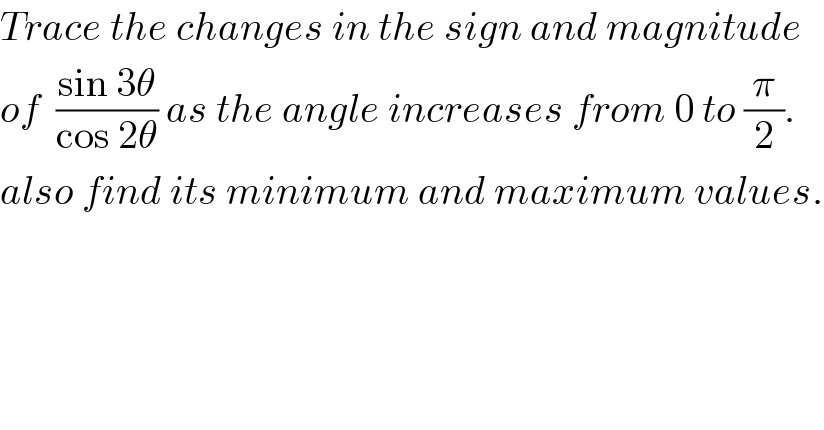
Question and Answers Forum
Question Number 58025 by Kunal12588 last updated on 16/Apr/19

Commented by Kunal12588 last updated on 16/Apr/19

Answered by tanmay last updated on 16/Apr/19
![(π/2)≥θ≥0 π≥2θ≥0 ((3π)/2)≥3θ≥0 A) sin3θ=+ve (π/6)≥θ≥0 cos2θ=+ve so ((sin3θ)/(cos2θ))=+ve when (π/6)≥θ≥0 B) sin3θ=+ve [when (π/4)> θ≥(π/6) cos2θ=+ve ((sin3θ)/(cos2θ))=++ve c)sin3θ= +ve when (π/3)≥θ>(π/4) cos2θ=−ve ((sin3θ)/(cos2θ))=−ve d)sin3θ= −ve (π/2)≥θ≥(π/3) cos2θ=−ve so ((sin3θ)/(cos2θ))=+ve pls check... f(θ)=((sin3θ)/(cos2θ)) (df/dθ)=((cos2θ×3cos3θ+2sin3θ×sin2θ)/(cos^2 2θ)) (df/dθ)=((cos2θ×cos3θ+2cos(3θ−2θ))/(cos^2 2θ)) (df/dθ)=((cos3θ×cos2θ+2cosθ)/(cos^2 2θ)) for max/min (df/dθ)=0 cos3θ×cos2θ+2cosθ (4x^3 −3x)(2x^2 −1)+2x 8x^5 −4x^3 −6x^3 +3x+2x 8x^5 −10x^3 +5x x(8x^4 −10x^2 +5) x{2(4x^4 −5x^2 )+5} x[2{(2x^2 )^2 −2×2x^2 ×(5/4)+((25)/(16))−((25)/(16))}+5] x[2(2x^2 −(5/4))^2 −((25)/8)+5] x[2(2x^2 −(5/4))^2 +((15)/8)] so [2(2x^2 −(5/4))^2 +((15)/8)]≠0 hence 8x^5 −10x^3 +5x=0 when x=0 cosθ=0=cos(π/2) [θ=(π/2)] f((π/2))=((sin(((3π)/2)))/(cos(((2π)/2))))=((−1)/(−1))=1(maximum value) f(0)=((sin(3×0))/(cos(2×0)))=0](Q58028.png)
Commented by Kunal12588 last updated on 17/Apr/19

| ||
Question and Answers Forum | ||
Question Number 58025 by Kunal12588 last updated on 16/Apr/19 | ||
 | ||
Commented by Kunal12588 last updated on 16/Apr/19 | ||
 | ||
Answered by tanmay last updated on 16/Apr/19 | ||
![(π/2)≥θ≥0 π≥2θ≥0 ((3π)/2)≥3θ≥0 A) sin3θ=+ve (π/6)≥θ≥0 cos2θ=+ve so ((sin3θ)/(cos2θ))=+ve when (π/6)≥θ≥0 B) sin3θ=+ve [when (π/4)> θ≥(π/6) cos2θ=+ve ((sin3θ)/(cos2θ))=++ve c)sin3θ= +ve when (π/3)≥θ>(π/4) cos2θ=−ve ((sin3θ)/(cos2θ))=−ve d)sin3θ= −ve (π/2)≥θ≥(π/3) cos2θ=−ve so ((sin3θ)/(cos2θ))=+ve pls check... f(θ)=((sin3θ)/(cos2θ)) (df/dθ)=((cos2θ×3cos3θ+2sin3θ×sin2θ)/(cos^2 2θ)) (df/dθ)=((cos2θ×cos3θ+2cos(3θ−2θ))/(cos^2 2θ)) (df/dθ)=((cos3θ×cos2θ+2cosθ)/(cos^2 2θ)) for max/min (df/dθ)=0 cos3θ×cos2θ+2cosθ (4x^3 −3x)(2x^2 −1)+2x 8x^5 −4x^3 −6x^3 +3x+2x 8x^5 −10x^3 +5x x(8x^4 −10x^2 +5) x{2(4x^4 −5x^2 )+5} x[2{(2x^2 )^2 −2×2x^2 ×(5/4)+((25)/(16))−((25)/(16))}+5] x[2(2x^2 −(5/4))^2 −((25)/8)+5] x[2(2x^2 −(5/4))^2 +((15)/8)] so [2(2x^2 −(5/4))^2 +((15)/8)]≠0 hence 8x^5 −10x^3 +5x=0 when x=0 cosθ=0=cos(π/2) [θ=(π/2)] f((π/2))=((sin(((3π)/2)))/(cos(((2π)/2))))=((−1)/(−1))=1(maximum value) f(0)=((sin(3×0))/(cos(2×0)))=0](Q58028.png) | ||
| ||
Commented by Kunal12588 last updated on 17/Apr/19 | ||
 | ||